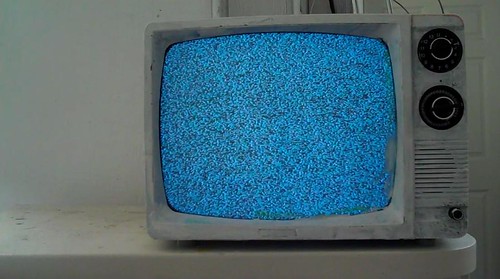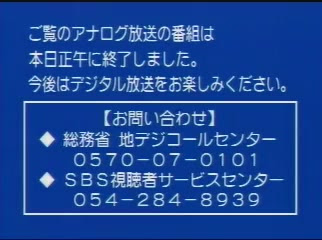July 2011
Ministry of Internal Affairs and Communications
Government of Japan
Japan Completed Analog Switch Off in Terrestrial Television Broadcasting Successfully
In Japan, the government, broadcasters, manufacturers, and many stakeholders have taken dedicated efforts to achieve the complete digitalization of terrestrial television broadcasting. ISDB-T, the Japanese standard for digital terrestrial television broadcasting, is the best of such technology, invented thanks to the national tendency of cooperation for solving issues and of seeking the newest useful functions for electrical appliances.
ISDB-T enables sophisticated HDTV, easy receiving in any conditions (e.g. wide cover area, anti-radio–disturbance, etc.), and prompt transmission of emergency information in disasters. These benefits have been spread deeply to citizens all over the country. In addition, mobile broadcasting called “One-Seg” has been bringing a new viewing experience without additional cost, while the other digital TV standards require additional cost.
By sharing this attractiveness and advantage fully, Japan was able to win trust in digital television broadcasting among citizens. Japan has suffered serious damage from the unprecedented earthquake and tsunami on 11th March, just before the Analog Switch Off (ASO). But now we are striving to reconstruct with kind help and friendship from all over the world and with an unbeatable national effort (“Ganbaro, Nippon!!”). During the disaster, many lives were saved by informing each person of the tsunami alert in advance through One-Seg. Only ISDB-T provides One-Seg, and for this reason, ISDB-T is the standard trusted by citizens, and the digitalization of terrestrial television broadcasting in Japan succeeded without changing the initial target date. Furthermore, we can guarantee that the Japanese standard will lead to success in the upcoming digitalization of terrestrial television broadcasting for countries that have adopted ISDB-T.
We hope that countries all over the world can share in the Japanese success by adopting ISDB-T. Japan has succeeded in the complete digitalization of terrestrial television broadcasting by terminating analog broadcasting on Sunday, 24th July, 2011, (except in some regions afflicted by the earthquake/tsunami damage). Digitalization for terrestrial television broadcasting is a worldwide trend. In Japan, more than 120 million people, almost the entire population, can watch television via terrestrial broadcasting. Japan is the first country in the world to succeed in an analog switch off without confusion in such a large-scale.
The Ministry of Internal Affairs and Communications (MIC) would like to share its success tips for the other countries planning ASO in the near future as shown below:
Success Tip 1: Preparation of Consultation offices close to citizens (working together with the government, broadcasters, manufacturers and electricians)
Television broadcasting is a universal service and an important infrastructure for most of the people to rely on as an information source. Therefore, it is indispensable to care for the people who are not familiar with digital technology, especially elderly people and people without enough income. The MIC put in place a total of 51 support centers for digital terrestrial viewers, called “Digi-Suppo,” in cooperation with broadcasters, manufactures and electricians in every prefecture to enable easy access and the asking of relevant questions.
In addition, especially just before the ASO, temporary Q&A booths to support people who had not switched to digital broadcasting yet were set up widely under cooperation with local governments. A lot of volunteers also supported by calling elderly people to confirm whether they had switched to digitalization.
This management structure consisting of the government, broadcasters, manufacturers, retailers and electricians was a key factor leading to the success of TV digitalization.
Success Tip 2: Implementation of measures along with a schedule and target
Regarding transmission network preparation, the schedule for starting digital broadcasting in each region was publicly announced (called the “master plan”). The master plan indicates that digital broadcasting would start in 3 metropolitan areas (Tokyo, Nagoya and Osaka) by 2003 and in mid-size cities by 2006. Also the starting dates for the other regions were also indicated in the plan. This schedule was announced in each region respectively.


After the construction of most of the transmission stations, the MIC returned its attention to fitting out an environment for receiving digital broadcasting waves from the point of view of the citizens. The Digi-Suppos helped citizens to solve any difficulties in their receiving system, including through consultations on a shared receiving system in areas where broadcast signals are blocked by mountains or hills or apartment complexes.
In the border area of analog broadcasting coverage, where the received signal level is very weak, a cliff effect might have occurred. Therefore, in such areas, additional measures were taken, such as newly installing shared receiving facilities or replacing antennas to high-gain antennas.
Furthermore, as a safety network for the areas where these measures could not be delivered before the ASO, the MIC and broadcasters delivered satellite networks as a temporary measure to broadcast terrestrial TV programs.
Success Tip 3: Measures for the spread of digital receivers
By standardizing the minimum functional requirements for set-top boxes (STBs) along with the technology development efforts of manufacturers, digital television and STB prices have steadily become cheaper, contributing to the spread of digital receivers as a result.
In addition, the government implemented an incentive program for consumers to purchase and switch to digital televisions (called the “eco-point” program), accelerating digital receiver diffusion. As a result, there were 25 million shipments of flat panel televisions in 2010 (in the first year of digitalization, there were 10 million shipments). In particular, the amount of sales in November is more than 5 times the amount of November 2009 due to announcing the 50% reduction of eco-points in advance.
As for a safety network for the people who had not prepared a digital receiver yet, STBs have been distributed for free to low income households since 2009.
Success Tip 4: Public announcements, including statistical results of the digital spread rate and the ASO notification through the analog broadcasting program
The government shared statistical results with viewers via the media, including the results of a survey on the household digital receiver spread rate and a survey on viewer’s awareness of the timing of the ASO. This showed viewers that digitalization was making steady progress.
Regarding the preparation of an environment in which all citizens can receive digital broadcasting waves, the status of digitalization using shared receiving systems and in apartment complexes was published to publicize the progress of digitalization.

On the other hand, broadcasters notified viewers that analog programs would end on 24th July through all channels broadcasting the same promotion program at the same time (called a “soft test”). The promotion program was in the letter-box format and the word “analog” and the telephone number of the call center were indicated on the screen viewers realized that they were now watching an analog program.
Suzu city (with approx. 10 thousand households) in Ishikawa prefecture switched off analog broadcasting one year prior to the nationwide ASO. Finally the results of these invaluable experiences contributed to the preparation for the nationwide ASO. From 1st July 2011, broadcasters inserted a superimposed image showing the days remaining until the day of the analog switch off on the screen in their analog programs as a final effort to avoid having unprepared households due to insufficient awareness raising.
These measures largely contributed to preventing confusion when analog television broadcasting was switched off successfully.
Success Tip 5: Spread of “ digitalization of Terrestrial Television Broadcasting ” to citizens by using characters and distinguished persons (Media strategy)
Industry side developed many campaigns and commercials by using an animal mascot, a famous entertainer as a symbolic of promotion and popular newsreaders as ambassadors of promotion. In addition, various generations recognized “digitalization of Terrestrial Television Broadcasting” through distinguished entertainers corresponding to the same generation, who were named as a cheering party and they participated in a lot of campaigns.
Furthermore, promotional clips appealed to fans at professional baseball/football stadiums and horse racing tracks using public viewing systems with huge screens. These measurements have created nationwide understanding of and familiarity forward “ digitalization of Terrestrial Television Broadcasting” as the animal mascot goods were great hits!


















